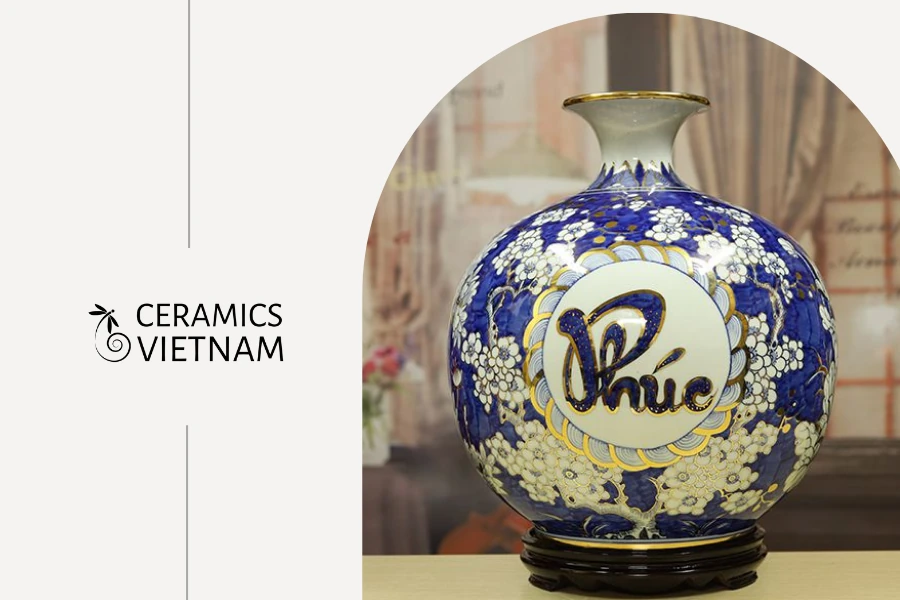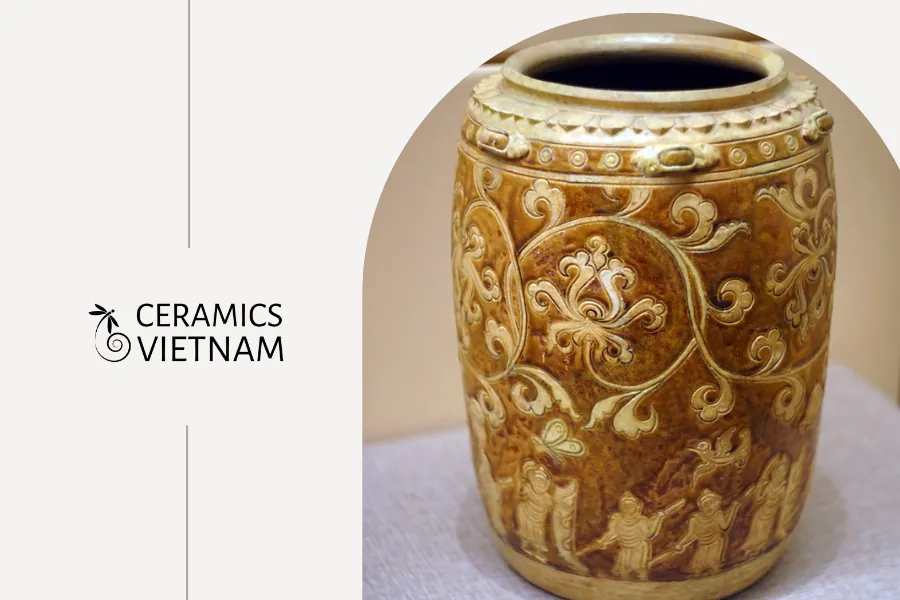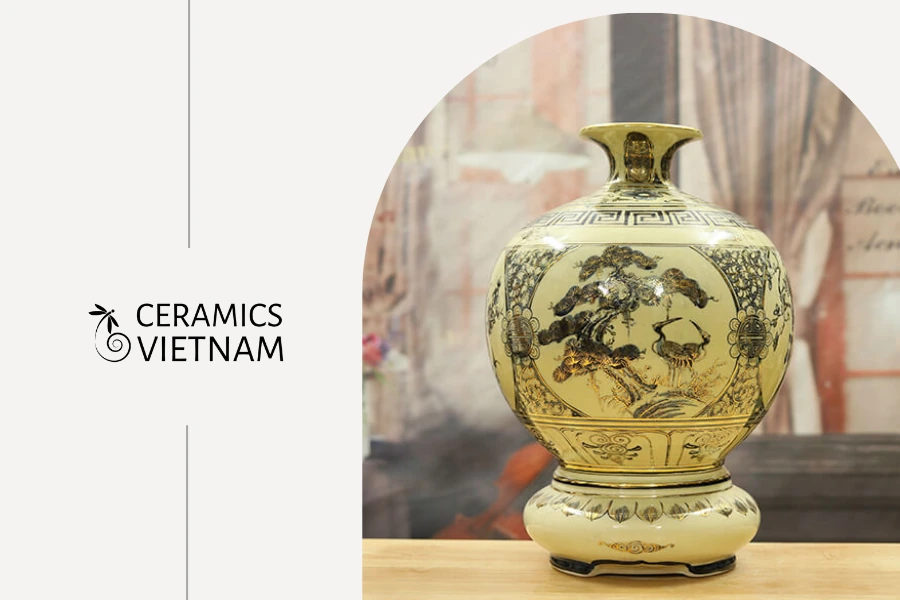Currently, our country has many ceramic products, with notable examples being Bat Trang and Chu Dau ceramics. For each type, they all have unique features that appeal to consumers. Is this achieved through external beauty or the feng shui significance inside? Let’s explore with Ceramics Vietnam to find out more about this matter.
Ceramics always have many interesting aspects that make customers feel satisfied, especially when they are crafted by skilled artisans. Therefore, renowned ceramics like Chu Dau and Bat Trang are particularly attractive. Comparing Chu Dau and Bat Trang ceramics is a way to further understand these famous ceramic brands. Let’s delve into the specifics:
Bat Trang village

Let’s compare Chu Dau and Bat Trang ceramics, what are the differences
Bat Trang village is situated on the banks of the Red River, approximately 10 kilometers southeast of Hanoi. Historically, Bat Trang was located on a prominent hill near the river, facilitating the production and transportation of pottery. Despite the passage of time, Bat Trang has retained its traditional manufacturing techniques and glaze colors.
The skilled artisans of Bat Trang shape white clay into exquisite and high-quality ceramics, requiring meticulous craftsmanship and a sophisticated manufacturing process. Today, Bat Trang boasts over 600 production areas, primarily operated by local villagers.
The Red River, also known as the Hong River, is one of Vietnam’s most important waterways. Stretching approximately 1,150 kilometers, it traverses the northern provinces of Vietnam before emptying into the Gulf of Tonkin. Renowned for its fertile soil, the Red River Delta is a vital agricultural region, producing rice, vegetables, fruits, and flowers. Additionally, the river supports diverse wildlife, including endangered species like the Red River dolphin and Vietnamese pheasant. Over the centuries, the Red River Valley has been inhabited by various ancient civilizations, leaving behind rich cultural heritage. In the modern era, the river has been utilized for hydroelectric power generation and serves as a crucial transportation route.
Chu Dau village

Let’s compare Chu Dau and Bat Trang ceramics, what are the differences
Chu Dau ceramics village is currently situated in the Minh Tan and Thai Tan communes of Nam Sach district, Hai Duong province. This pottery village is located approximately 10 kilometers from the center of Hai Duong City, making it a popular weekend destination for many travel enthusiasts.
Chu Dau ceramics village is a locality that preserves the traditional craft of making ancient ceramics, with various areas dedicated to the production and crafting of pottery. Few may be aware that the pottery craft in Chu Dau village is the cradle for the formation and development of the country’s expertise in this field. Many products produced in Chu Dau ceramics village have gained recognition, reaching far and appearing in renowned ceramic museums worldwide.
What are the characteristics of Bat Trang ceramics?

Let’s compare Chu Dau and Bat Trang ceramics, what are the differences?
This is a famous line of ceramics that has been present in Vietnam for quite some time. It always depicts natural beauty in a gentle and vivid way, expressed through fundamental elements such as:
- Decorative patterns: In terms of form, there are both engraved and embossed decorative styles. The depicted patterns may include dragons, phoenixes, lotus flowers, and feng shui symbols. The intricate patterns stand out beautifully, especially under the skilled hands of Bat Trang artisans.
These patterns seem to come alive with a dynamic quality. Prominent products of Bat Trang ceramics include bowls, teapots, incense burners, feng shui items, and decorative pieces.
- Glaze types used in Bat Trang ceramics: Currently, there are five types of glaze that contribute to Bat Trang ceramics:
- Blue glaze: Ceramic glaze combined with cobalt oxide for blue color. Artisans use this glaze along with a brush to paint on ceramics. After painting with blue glaze, a layer of shiny glaze is applied to ensure durability after firing. This type of glaze has been used in Bat Trang since the 14th century and remains in use today. The color intensity ranges from light blue to dark blue.
- Brown glaze: This is one of the earliest glazes used in Bat Trang. The color of the glaze depends largely on the ceramic bone. This glaze is not overly shiny, and the surface may have a slightly rough texture. Sometimes, after applying the glaze, artisans scrape off a layer to give the product a more rustic appearance.
- White glaze: After using glaze for a period, it may turn ivory yellow. The product will appear shinier when reaching a high temperature or may turn opaque, milky white. White glaze always adds a distinctive touch to Bat Trang ceramics.
- Moss green glaze: This glaze is still used to paint clouds or embellish various areas such as lamp bases, incense burner stands, etc. Moss green glaze is used to highlight certain areas, creating an impressive effect for the viewer.
- Crackled glaze: Typically, this glaze is used for antique ceramic products. It appeared in the 16th century and has a grayish ivory color with crack patterns. Moreover, it is used in various types of ceramics such as lidded teapots, ancestral altars, and pairs of mythical creatures. Both embossed and engraved patterns can be used with this glaze.
- Cultural refinement in Bat Trang ceramics: When comparing Chu Dau and Bat Trang ceramics, this aspect cannot be overlooked. Cultural refinement is demonstrated through engraved patterns or the use of blue glaze on white glaze. Often, these details reveal the number of years or the hometown of the artisan who created the product.
What are the distinctive features of Chu Dau ceramics?

Let’s compare Chu Dau and Bat Trang ceramics, what are the differences
When it comes to Chu Dau ceramics, it can be said that this is truly a type of pottery that brings interesting and exquisite qualities. There are many fascinating aspects that we can mention, such as:
- Decorative patterns: Chu Dau ceramics feature various patterns engraved on the pottery. Excavations from the period between 1986 and 1993 revealed that Chu Dau ceramics have an elegant shape. The patterns often depict images of rural life in Vietnam, including birds, boat leaves, chrysanthemum flowers, lotus flowers, as well as motifs like mountain shapes, quartet figures, turtles, and fish. All of these contribute to a lively and harmonious appearance for the products. The patterns also reflect much about rural life in Vietnam and can be either engraved or embossed.
- Ceramic glazes: The peak period of Vietnamese ceramics was in the late 14th century, with various unique glazes and patterns such as pearl glaze, white glaze, green glaze, brown glaze, etc. The pearl glaze in the Chu Dau era feels heavy when held and has a coarser texture, with a less clear sound when tapped compared to Chinese pearl glaze.
Among these, white glaze with incised and three-strand glazes are more commonly used. Their widespread use is due to the excellent qualities they bring. These glazes are meticulously applied to every smallest design detail of the product, making the beauty of Chu Dau ceramics no different from the glazes of the Ming Dynasty in China.
- Types and styles: In terms of shapes, Chu Dau ceramics offer a wide variety, including bowls, dishes, plates, teacups, incense burners, and feng shui items. Tea pots from the Ly period often have dragon head-shaped spouts, Makara (mythical sea creature in Hindu mythology) spouts, bird-shaped spouts, elephant trunk-shaped spouts, and Garuda (the mythical bird of Vishnu in Hinduism).
Bowls and dishes from the Ly period often still bear clear marks of the tripod. However, Chu Dau ceramics, crafted by skilled artisans, do not exhibit these tripod marks. The bottoms of Ly period ceramics are often left unglazed, while the bottoms of Chu Dau ceramics are usually coated with a thin layer of brown glaze. This layer is not an actual glaze but a very thin layer of brown pigment applied to protect the base of the dish. This is a characteristic that helps distinguish Vietnamese ceramics from Chinese ceramics, as Chinese ceramics typically do not have this brown coating or are left unglazed.
It can be said that throughout many years of existence and development, Chu Dau ceramics seem to maintain their traditional characteristics. They still embody the traditional crackled white glaze, which is highly favored by users.
To compare Chu Dau and Bat Trang ceramics is indeed challenging. Regarding quality, both are outstanding, not to mention aesthetic appeal. However, when it comes to diversity, Bat Trang ceramics offer a wider range of varieties. Yet, Chu Dau ceramics bring an elegance that is hard to put into words. Truly, it’s a challenge to make the right choice, isn’t it?














Leave a reply